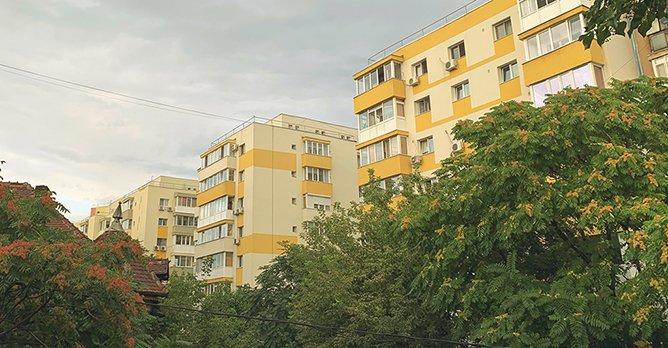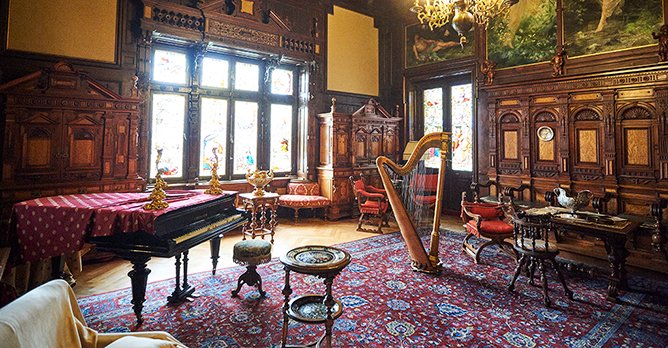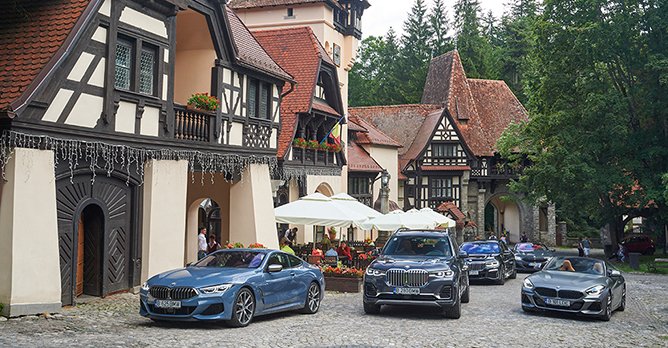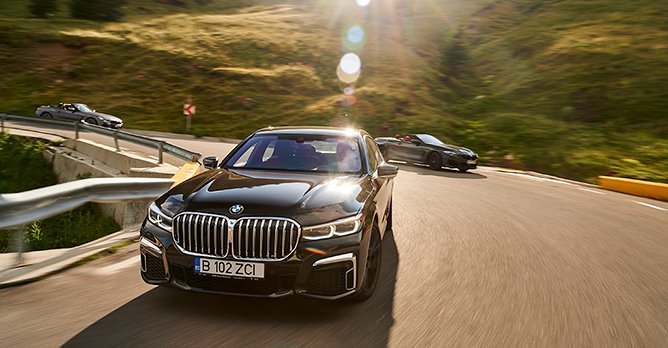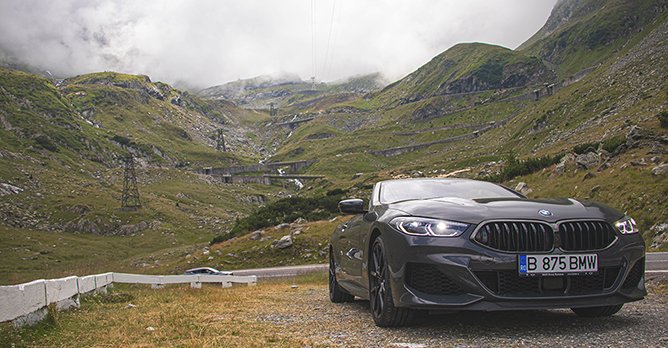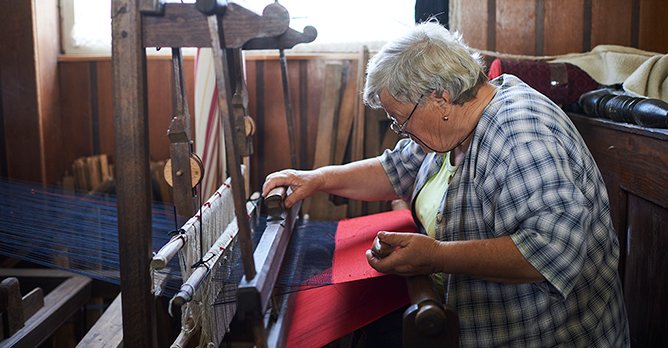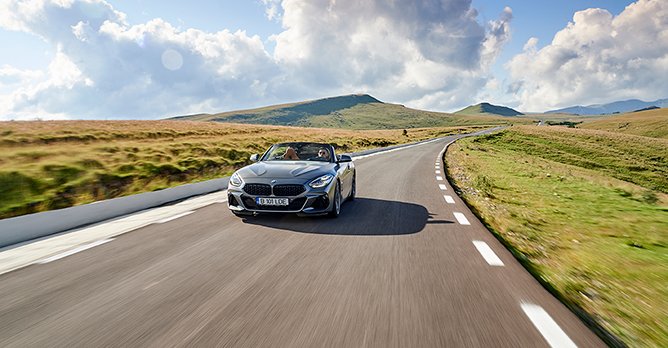The hunt for Dracula and the greatest driving road in the world
03 Aug 2019|11,722 views
Bucharest... isn't pretty. The vestiges of communist rule, turmoil and hardship permeate the city. Within a sweep of your gaze, you will pick out old Parisian style buildings, modern condominiums and stark communist apartments, interspersed with the occasional abandoned building and construction projects in varying stages of completion.
I'm in Romania, though I can't say I'm 100% sure why. But I know two things about Romania (or at least I think I do) - it's home to Dracula, as well as the Transfagarasan Highway, sometimes referred to as the 'greatest driving road in the world'.
I have four days here and five BMWs to drive. Let the hunt begin.
City and colour
Bucharest, the capital city of Romania, is a city defined by contrast and conflict. Not just in its history, but present day too. It's one of the most congested cities in the world car-wise, abandoned buildings with collapsed roofs can be found on many streets, and it's not generally a very visually vibrant city (the fact that it was raining didn’t help).
And yet, the city has its charms. Quaint side streets just two minutes off the main boulevard reveal a softer side of Bucharest. The country's colourful history also only reveals itself once you talk to someone who knows a thing or two (our guide had 4.5 hours worth of knowledge).
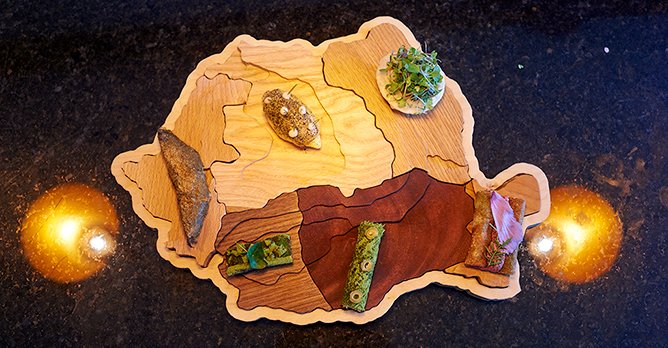
At the same time, there's an air of hope and opportunity.
Take Cristina Mazilu for example, a former music journalist turned food blogger turned chef and business owner, now running her own culinary space that at once serves as an office, an experimental kitchen as well as a dinner party venue. Or Noua, a high-end restaurant serving New Romanian Cuisine using 95% locally sourced ingredients, run by a young but stellar chef.
Travel out of Bucharest and the country transforms. Sinaia is a beautiful ski resort that is more quaint Swiss town than communist village. It's beautiful, scenic and strangely upmarket.
I had the pleasure of driving the X7 during this time, munching up long stretches of tarmac with ease. By switching the dynamic cruise control on, I could effectively drive with one hand. It's comfortable, soft riding yet amply powerful - a perfect car for long journeys.
Located in Sinaia is the Peles Castle (no Dracula here), a stunning neo-Renaissance castle that is about as eclectic as they come. The 160 rooms inside are built and decorated in wide-ranging styles - inside the heavily Baroque-influenced castle dominated by carved wood, you will find rooms of Florentine, Turkish, Moorish, and French influence. This complex mix of styles and influences certainly say a lot about Romania and its culture.
Surprisingly, the Peles Castle was also extremely modern for its time. It was the first European castle to have electricity, had hot and cold running water, a central heating and vacuum system, and even a mechanically sliding stained glass roof in the main foyer.
In recent years, the Peles Castle has also been the location of the Sinaia Concours d'Elegance - it may not have the eminence and exotica of more famous events like Pebble Beach, but it's a fascinating event nonetheless, an event focused on telling compelling automotive stories. The 2019 event featured a seven-decade old BMW 327 Convertible that Eduard Eckers used to escape from communist Romania. To this day, the car still bears the exact scars from when, back in 1969, he hit a tree while attempting to cross the border through the woods.
A slice of heaven
Head out of the city and into the mountains, and Romania transforms once more. This is God's country, automotive heaven. Spaghetti tarmac dropped down from the heavens, laced around dramatic, beautiful mountainside. When people talk about great driving roads, this is what they are talking about. The tarmac is as beautifully smooth and flowing as the scenery is jaw-dropping and breathtakingly beautiful.
Draped over the Fagaras mountains is the now-famous Transfagarasan highway, a 114km stretch of road that rises to an elevation of 2,000m.
Built as a strategic military route by Communist dictator Nicolae Ceausescu in the 1970s, the road serves little actual practical purpose. Indeed, when the road was built, there was already a quicker and easier way (the Valea Oltuluito) cross the Fagaras mountains.
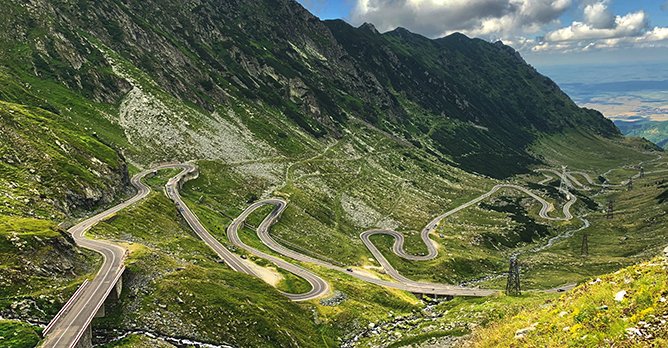
These days, it has become a tourism hot spot, and for good reason. Surrounded by epic mountain faces and dramatic valleys, the place is stunning on epic proportions. You take in eye-wateringly beautiful sights and breathe crisp air tinged with just the hint of pine, the serene quietness of the place interspersed with the rumble of engines - cars (and bikes) paying their respects to this automotive chapel.

You would think that the best cars for these roads are either the Z4 or the 8 Series Convertible, and you would be right. Sort off. The Z4 is a blast - lively, alert and great fun if you know what you are doing. The 8 Convertible, while not quite as dynamic (a little slow on turn in and prone to understeer), still delivers ample drama, helped by the sonorous V8 soundtrack.
The revelation of the trip, though, was the 7 Series 750Ld. Light on its feet, plenty of punch, sharp on turn in and better at holding it's line mid-corner than the 8 Convertible, the 7 Series surprised and impressed. And when you're done with the twisty bits, it returns to its element on straight roads, offering a soothing, refined and comfortable experience all the way.
Into the wild
After traversing the Transfagarasan Highway, our stopover for the night was the Count Kalnoky Guest House (still no Dracula sighting). It's located in Miclosoara, a quiet village of 500 so pristinely untouched by modernity that you can pick out several major constellations in the night sky with your naked eye.
This is a land untouched by the unrelenting forward march of modernity, technology and time. A place where hand-pumped water and horse-drawn carts are still a part of some people's daily lives. It's a stark departure from the world we know. It offers a look at the pressures of daily life, where wealth and well-being aren't atomically entangled.
Traditional craftsmen persevere in time-honoured businesses like weaving, furniture crafting and watermill-ground flour. The high level of intricate craftsmanship remains unvarnished by technology. These aren't thriving businesses, obviously. These craftsmen persist because of heritage, obligation, responsibility and a dedication to the craft. In this day and age where any product is one Taobao click away, it's refreshing to see handcrafted objects steeped in hard work, beauty and history.
There is, of course, the persistent sense of history and modernity at odds. That's a sensation that can also be found in a modern BMW. On one hand, there's the promise of the ultimate driving machine - unadulterated driver-car interaction distilled to deliver the sheer joy of driving. There's a reason some people sentimentally lust after classic cars (I did), and these characteristics still endure to this day.
On the other hand, new cars are packed full with technology that gets in between that human-car analogue. Some for the better, of course - traction control and ESP ensures you can actually get to the top of Fagaras, and not be a crumpled ball of metal down in the valley. But other driver intervention systems (usually of the semi-autonomous variety) can also impede your 'true' driving sensation.
Reset
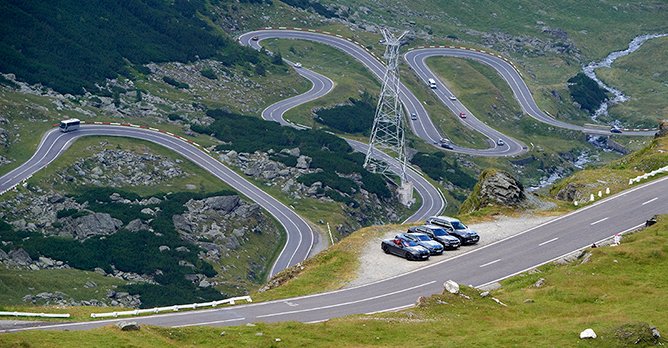
Whether it piloting a brand new BMW X7 through a quaint village, unleashing the 8 Series Coupe's V8 through a tunnel, or hustling a Z4 up a serpentine mountain road, the act of driving itself allows you to, if just for a moment, escape from the incessant pressures of the modern world. Driving through Romania obliges you to find joy in the simple things - the serenity of the passing scenery, the beauty of unblemished countryside, and the way life slows down once you leave the city.
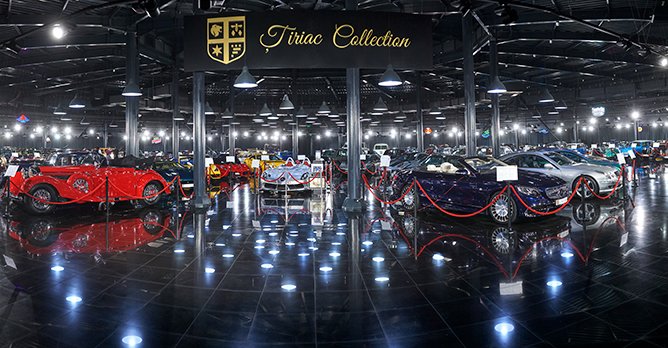
The eclectic mix of BMWs on this trip - eager roadster, sporty GTs, luxury limo and gigantic SUV - is also entirely fitting for a country that proved to be such a complex mix of histories, cultures and personalities.
It's a country where the past and the future are at odds. From traditional craftsmanship to modern new endeavour, Romania is a country that very much embraces this dichotomy. It's this subliminal space between old and new, between ambition and frustration, that I find Romania to be the most interesting.
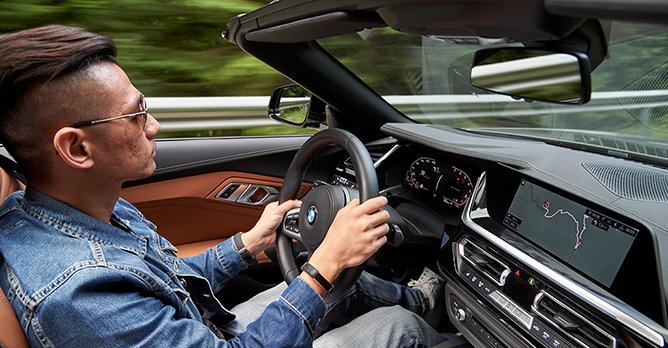
It doesn't always have to be pretty, and it certainly is never easy, but it is this perpetual transformation that is the most exciting.
Bucharest... isn't pretty. The vestiges of communist rule, turmoil and hardship permeate the city. Within a sweep of your gaze, you will pick out old Parisian style buildings, modern condominiums and stark communist apartments, interspersed with the occasional abandoned building and construction projects in varying stages of completion.
I'm in Romania, though I can't say I'm 100% sure why. But I know two things about Romania (or at least I think I do) - it's home to Dracula, as well as the Transfagarasan Highway, sometimes referred to as the 'greatest driving road in the world'.
I have four days here and five BMWs to drive. Let the hunt begin.
City and colour
Bucharest, the capital city of Romania, is a city defined by contrast and conflict. Not just in its history, but present day too. It's one of the most congested cities in the world car-wise, abandoned buildings with collapsed roofs can be found on many streets, and it's not generally a very visually vibrant city (the fact that it was raining didn’t help).
And yet, the city has its charms. Quaint side streets just two minutes off the main boulevard reveal a softer side of Bucharest. The country's colourful history also only reveals itself once you talk to someone who knows a thing or two (our guide had 4.5 hours worth of knowledge).

At the same time, there's an air of hope and opportunity.
Take Cristina Mazilu for example, a former music journalist turned food blogger turned chef and business owner, now running her own culinary space that at once serves as an office, an experimental kitchen as well as a dinner party venue. Or Noua, a high-end restaurant serving New Romanian Cuisine using 95% locally sourced ingredients, run by a young but stellar chef.
Travel out of Bucharest and the country transforms. Sinaia is a beautiful ski resort that is more quaint Swiss town than communist village. It's beautiful, scenic and strangely upmarket.
I had the pleasure of driving the X7 during this time, munching up long stretches of tarmac with ease. By switching the dynamic cruise control on, I could effectively drive with one hand. It's comfortable, soft riding yet amply powerful - a perfect car for long journeys.
Located in Sinaia is the Peles Castle (no Dracula here), a stunning neo-Renaissance castle that is about as eclectic as they come. The 160 rooms inside are built and decorated in wide-ranging styles - inside the heavily Baroque-influenced castle dominated by carved wood, you will find rooms of Florentine, Turkish, Moorish, and French influence. This complex mix of styles and influences certainly say a lot about Romania and its culture.
Surprisingly, the Peles Castle was also extremely modern for its time. It was the first European castle to have electricity, had hot and cold running water, a central heating and vacuum system, and even a mechanically sliding stained glass roof in the main foyer.
In recent years, the Peles Castle has also been the location of the Sinaia Concours d'Elegance - it may not have the eminence and exotica of more famous events like Pebble Beach, but it's a fascinating event nonetheless, an event focused on telling compelling automotive stories. The 2019 event featured a seven-decade old BMW 327 Convertible that Eduard Eckers used to escape from communist Romania. To this day, the car still bears the exact scars from when, back in 1969, he hit a tree while attempting to cross the border through the woods.
A slice of heaven
Head out of the city and into the mountains, and Romania transforms once more. This is God's country, automotive heaven. Spaghetti tarmac dropped down from the heavens, laced around dramatic, beautiful mountainside. When people talk about great driving roads, this is what they are talking about. The tarmac is as beautifully smooth and flowing as the scenery is jaw-dropping and breathtakingly beautiful.
Draped over the Fagaras mountains is the now-famous Transfagarasan highway, a 114km stretch of road that rises to an elevation of 2,000m.
Built as a strategic military route by Communist dictator Nicolae Ceausescu in the 1970s, the road serves little actual practical purpose. Indeed, when the road was built, there was already a quicker and easier way (the Valea Oltuluito) cross the Fagaras mountains.

These days, it has become a tourism hot spot, and for good reason. Surrounded by epic mountain faces and dramatic valleys, the place is stunning on epic proportions. You take in eye-wateringly beautiful sights and breathe crisp air tinged with just the hint of pine, the serene quietness of the place interspersed with the rumble of engines - cars (and bikes) paying their respects to this automotive chapel.

You would think that the best cars for these roads are either the Z4 or the 8 Series Convertible, and you would be right. Sort off. The Z4 is a blast - lively, alert and great fun if you know what you are doing. The 8 Convertible, while not quite as dynamic (a little slow on turn in and prone to understeer), still delivers ample drama, helped by the sonorous V8 soundtrack.
The revelation of the trip, though, was the 7 Series 750Ld. Light on its feet, plenty of punch, sharp on turn in and better at holding it's line mid-corner than the 8 Convertible, the 7 Series surprised and impressed. And when you're done with the twisty bits, it returns to its element on straight roads, offering a soothing, refined and comfortable experience all the way.
Into the wild
After traversing the Transfagarasan Highway, our stopover for the night was the Count Kalnoky Guest House (still no Dracula sighting). It's located in Miclosoara, a quiet village of 500 so pristinely untouched by modernity that you can pick out several major constellations in the night sky with your naked eye.
This is a land untouched by the unrelenting forward march of modernity, technology and time. A place where hand-pumped water and horse-drawn carts are still a part of some people's daily lives. It's a stark departure from the world we know. It offers a look at the pressures of daily life, where wealth and well-being aren't atomically entangled.
Traditional craftsmen persevere in time-honoured businesses like weaving, furniture crafting and watermill-ground flour. The high level of intricate craftsmanship remains unvarnished by technology. These aren't thriving businesses, obviously. These craftsmen persist because of heritage, obligation, responsibility and a dedication to the craft. In this day and age where any product is one Taobao click away, it's refreshing to see handcrafted objects steeped in hard work, beauty and history.
There is, of course, the persistent sense of history and modernity at odds. That's a sensation that can also be found in a modern BMW. On one hand, there's the promise of the ultimate driving machine - unadulterated driver-car interaction distilled to deliver the sheer joy of driving. There's a reason some people sentimentally lust after classic cars (I did), and these characteristics still endure to this day.
On the other hand, new cars are packed full with technology that gets in between that human-car analogue. Some for the better, of course - traction control and ESP ensures you can actually get to the top of Fagaras, and not be a crumpled ball of metal down in the valley. But other driver intervention systems (usually of the semi-autonomous variety) can also impede your 'true' driving sensation.
Reset

Whether it piloting a brand new BMW X7 through a quaint village, unleashing the 8 Series Coupe's V8 through a tunnel, or hustling a Z4 up a serpentine mountain road, the act of driving itself allows you to, if just for a moment, escape from the incessant pressures of the modern world. Driving through Romania obliges you to find joy in the simple things - the serenity of the passing scenery, the beauty of unblemished countryside, and the way life slows down once you leave the city.

The eclectic mix of BMWs on this trip - eager roadster, sporty GTs, luxury limo and gigantic SUV - is also entirely fitting for a country that proved to be such a complex mix of histories, cultures and personalities.
It's a country where the past and the future are at odds. From traditional craftsmanship to modern new endeavour, Romania is a country that very much embraces this dichotomy. It's this subliminal space between old and new, between ambition and frustration, that I find Romania to be the most interesting.

It doesn't always have to be pretty, and it certainly is never easy, but it is this perpetual transformation that is the most exciting.
Thank You For Your Subscription.



































